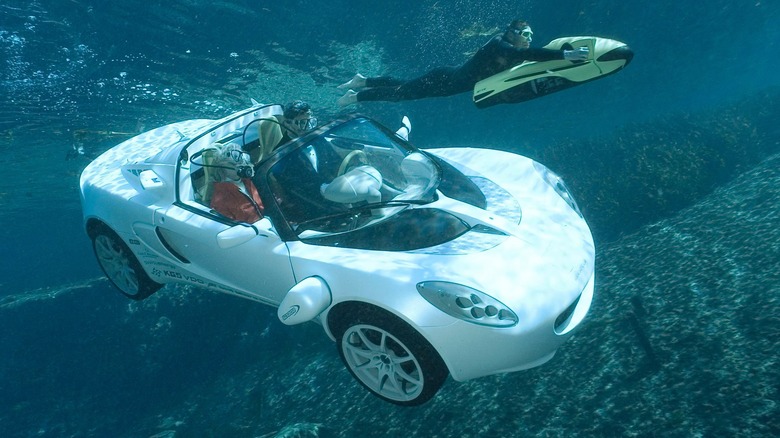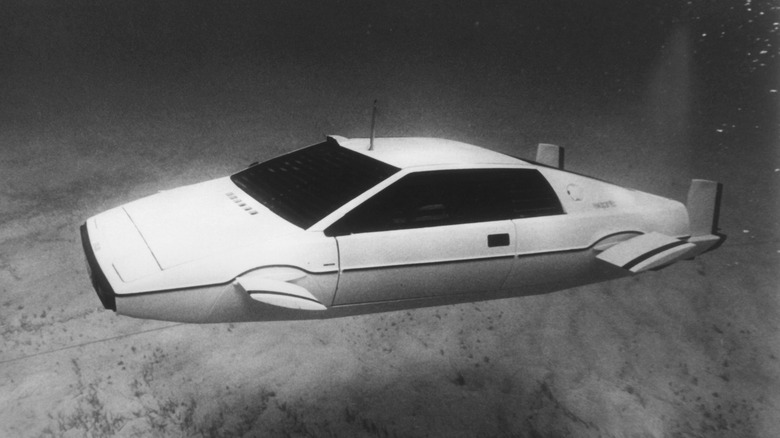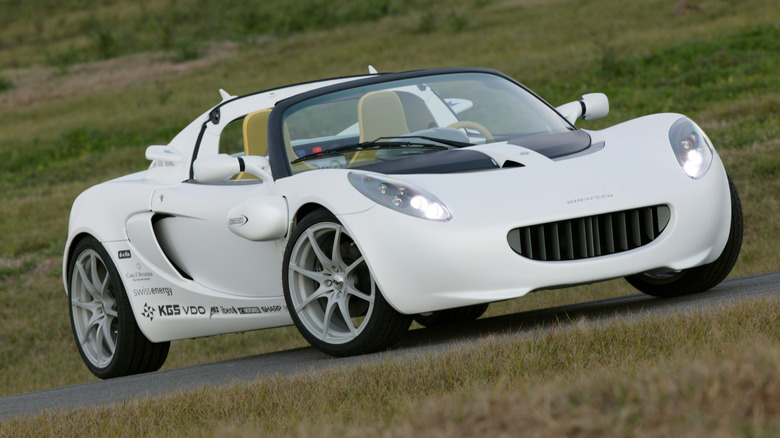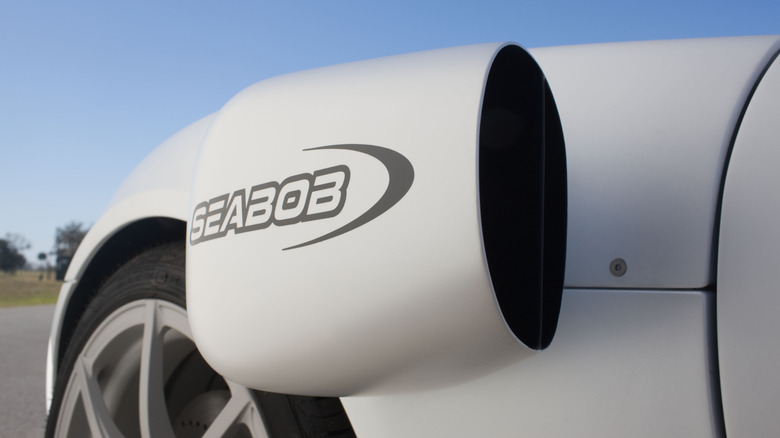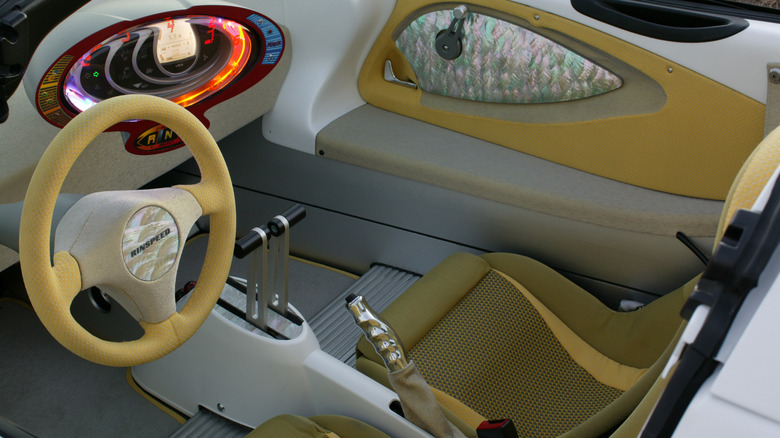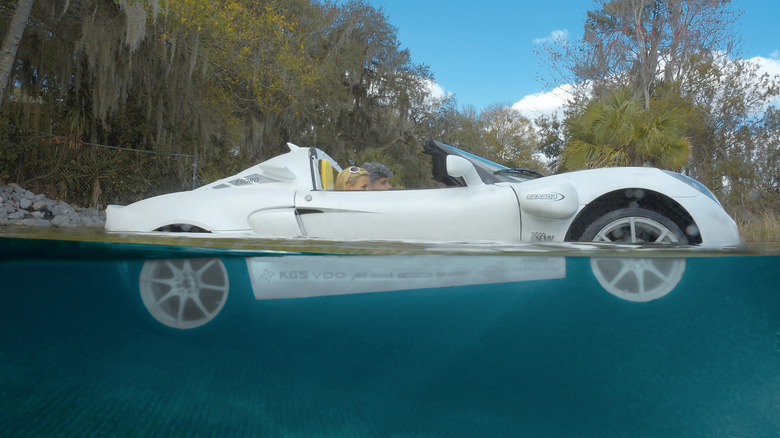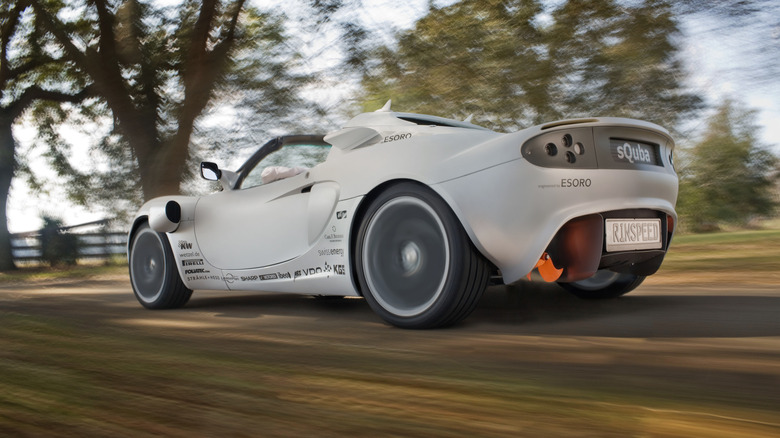This Swiss Car Company Built A Scuba-Diving Lotus Elise EV
Modern EVs are more capable than ever. They boast longer range, better tech, and faster charging times, and EVs are even better than regular combustion engines in some ways too. But none of them can travel underwater. It's safe to say amphibious capabilities aren't at the top of the priorities list for any mainstream EV makers, but that didn't stop Swiss automaker Rinspeed from building a seaworthy roadster back in 2008. Rinspeed is a name many car enthusiasts might not have heard of, but the boutique brand has been building weird and wonderful one-offs for over 30 years.
Watercraft has been a running theme throughout many of Rinspeed's vehicles, with the brand's earlier projects including a pickup truck with a built-in "underwater motor scooter" and an open-seat sports car that turned into a hydrofoil. However, it's the 2008 Squba that takes the crown as the brand's most madcap amphibious invention. Perhaps what's most surprising about it, though, is that despite the car sounding like science fiction, it actually worked.
The inspiration behind the Squba
Rinspeed founder Frank M. Rinderknecht is a noted "James Bond" fan, and holds a special reverence for the 1977 movie, "The Spy Who Loved Me." The movie famously features a modified Lotus Esprit that can transform into a submarine. Multiple prop cars were used for filming but none of them could fully function as both a submersible and a road car. Instead, each sequence was filmed in stages, with the underwater scenes filmed using a Esprit body shell that had been converted into a submersible, using electric motors for propulsion. Fun fact: Elon Musk currently owns the Lotus used for the fully underwater scenes.
Rinderknecht decided to go one better and not only build a modern tribute to the iconic movie car, but to ensure that it could drive on land as well as be fully functional underwater. To be able to return from its aquatic escapades, the car would also need to be able to sink and float on demand, adding an extra engineering challenge for the Rinspeed team.
A Lotus Elise EV
The Lotus Elise was chosen as a starting point for the project — not quite an Esprit, but still one of the best Lotus cars of all time — and the finished car still closely resembled it. An open-top sports car was necessary for several reasons: firstly, for safety. The driver and passenger would need to be able to easily evacuate the car in case of an emergency. Water pressure would make exiting through doors potentially impossible, but with no roof, occupants could simply unstrap their harnesses and float away.
The second reason concerned the car's ability to float and sink on demand. Adding a roof, and therefore an enclosed interior filled with air, would make it significantly more difficult for the car to overcome its inherent buoyancy. Rinspeed calculated that the car's weight would need to increase by two tons to be able to sink at the required rate, and for performance reasons that was out of the question. With the open-top design, all that was needed to begin the sinking process was for the occupants to open the door to let water in.
Powered by three electric motors and two jet drives
The amphibious nature of the project meant that the Elise's stock gas engine was of no use to the Squba. Instead, Rinspeed needed a powertrain that could be fully waterproofed, and so chose to use a series of electric motors and jet drives. A single electric motor, integrated into the rear of the car, served as the sole means of powering it on land. Given the car's curb weight was only 2,208 lbs, that was enough to propel the car from 0-62 mph in 7.1 seconds and reach a top speed of around 75 mph — hardly sports-car territory, but more than enough to make it drivable on the road.
Two further electric motors, also mounted at the back of the car, served to power the screw propellers for traveling underwater. They were paired with two electric Seabob jet drives, giving the car a maximum speed on the water of around 3.2 knots and an underwater speed of around 1.6 mph. For context, that's roughly double the underwater swimming speed of the average scuba diver.
Waterproofing the rest of the car
As well as waterproofing the powertrain, Rinspeed needed to ensure every other aspect of the car, from its gauges to its upholstery, could handle being underwater for extended periods. To ensure its instrument cluster was up to the task, the automaker enlisted Continental, best known to many consumers for its performance-oriented tires. Specialists at Continental's interior division developed a bespoke digital cluster shaped like a manta ray, plus a set of physical interior controls designed to be used while wearing diving gloves.
The interior was designed in collaboration with a leading German textile manufacturer and was designed to be salt-resistant to cope with prolonged exposure to seawater. Rather than attempt to waterproof the upholstery, the fabric used throughout the car was instead designed to dry out quickly after the Squba resurfaced. The use of "spacer fabric" also cut down the amount of water the upholstery retained while diving, minimizing its weight gain between entering and exiting the water.
The Squba was more than a concept
To prove it was more than a mere concept, Rinspeed invited select journalists to experience the car for themselves in the waters of Lake Geneva, Switzerland. It proved to be capable of doing exactly what its makers claimed, zipping around Swiss country roads before driving into Lake Geneva and using its jets to force its way beneath the surface. Making full use of the car's onboard air supply, testers donned diving suits and watched as the car they were driving slowly turned into a fully functional submersible.
There were, of course, some limitations: The car was powered by six lithium-ion watercraft batteries, giving it far less capacity than the average road-going EV. Rinspeed, tellingly, never officially released any details about the car's range, but obviously, it was never going to dive to the deepest depths of the ocean. It was also eye-wateringly expensive to build. The finished project reportedly cost Rinspeed more than one million euros to complete at the time, which is approximately $2.12 million in today's money. The sheer cost alone ruled out any ideas of wider production, even as a novelty billionaire's toy. After all, it's extremely unlikely that most billionaires would cough up seven figures for a car that the (unfairly) hated Toyota Prius could overtake, even if it did double up as a submersible. Plus, Americans may not have been able to drive it all, as some models of the Lotus Elise were banned in the United States.
There are no modern successors
The development cost of the Squba was staggering back in 2008, and despite advances in EV tech, there's no reason to think that a modern-day equivalent wouldn't be similarly pricey. Even if a carmaker could reduce the cost of developing a new amphibious EV, it still seems unlikely anyone would be willing to buy it. Various niche automakers have attempted to sell amphibious vehicles over the years — the Amphicar was famously a favorite of former U.S. President Lyndon B. Johnson, and billionaire Richard Branson used a Gibbs Aquada to break a record for crossing the English Channel in 2004. However, none of these cars managed to achieve anything more than novelty status.
Chinese auto giant BYD is the latest to dabble in waterproofing its EVs, with its upscale Yangwang U8 SUV able to seal itself shut and float on water for short periods. However, the idea of a fully submersible car has never been revisited since Rinspeed's Squba project. That leaves the Swiss car a truly unique creation, one of many wacky one-offs in Rinspeed's back catalog.
